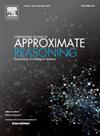GTransformer: Multi-view functional granulation and self-attention for tabular data modeling
IF 3
3区 计算机科学
Q2 COMPUTER SCIENCE, ARTIFICIAL INTELLIGENCE
引用次数: 0
Abstract
To bridge the performance gap between deep learning models and tree ensemble methods in tabular data tasks, we propose GTransformer, a novel deep architecture that innovatively integrates granular computing and self-attention mechanisms. Our approach introduces a scalable granulation function set, from which diverse functions are randomly sampled to construct multi-view feature granules. These granules are aggregated into granule vectors, forming a multi-view functional granulation layer that provides comprehensive representations of tabular features from multiple perspectives. Subsequently, a Transformer encoder driven by granule sequences is employed to model deep interactions among features, with predictions generated via a hierarchical multilayer perceptron (MLP) classification head. Experiments on 12 datasets show that GTransformer achieves an average AUC of 92.9%, which is comparable to the 92.3% performance of LightGBM. Compared with the current mainstream deep model TabNet, the average AUC gain is 2.74%, with a 14.5% improvement on the Sonar dataset. GTransformer demonstrates strong robustness in scenarios with noise and missing data, especially on the Credit and HTRU2 datasets, where the accuracy decline is 24.73% and 17.03% less than that of MLP-Head respectively, further verifying its applicability in complex real-world application scenarios.
GTransformer:用于表格数据建模的多视图功能粒化和自关注
为了弥合深度学习模型和树集成方法在表格数据任务中的性能差距,我们提出了一种新的深度架构GTransformer,它创新地集成了颗粒计算和自关注机制。我们的方法引入了一个可扩展的粒化函数集,从中随机抽取不同的函数来构建多视图特征粒。这些颗粒聚集成颗粒向量,形成一个多视图功能造粒层,从多个角度提供表格特征的综合表示。随后,采用由颗粒序列驱动的Transformer编码器对特征之间的深度交互进行建模,并通过分层多层感知器(MLP)分类头生成预测。在12个数据集上的实验表明,GTransformer的平均AUC达到了92.9%,与LightGBM的92.3%相当。与当前主流深度模型TabNet相比,平均AUC增益为2.74%,在Sonar数据集上提高了14.5%。GTransformer在存在噪声和缺失数据的场景下表现出了较强的鲁棒性,尤其是在Credit和HTRU2数据集上,其准确率降幅分别比MLP-Head小24.73%和17.03%,进一步验证了其在复杂的现实应用场景中的适用性。
本文章由计算机程序翻译,如有差异,请以英文原文为准。
求助全文
约1分钟内获得全文
求助全文
来源期刊

International Journal of Approximate Reasoning
工程技术-计算机:人工智能
CiteScore
6.90
自引率
12.80%
发文量
170
审稿时长
67 days
期刊介绍:
The International Journal of Approximate Reasoning is intended to serve as a forum for the treatment of imprecision and uncertainty in Artificial and Computational Intelligence, covering both the foundations of uncertainty theories, and the design of intelligent systems for scientific and engineering applications. It publishes high-quality research papers describing theoretical developments or innovative applications, as well as review articles on topics of general interest.
Relevant topics include, but are not limited to, probabilistic reasoning and Bayesian networks, imprecise probabilities, random sets, belief functions (Dempster-Shafer theory), possibility theory, fuzzy sets, rough sets, decision theory, non-additive measures and integrals, qualitative reasoning about uncertainty, comparative probability orderings, game-theoretic probability, default reasoning, nonstandard logics, argumentation systems, inconsistency tolerant reasoning, elicitation techniques, philosophical foundations and psychological models of uncertain reasoning.
Domains of application for uncertain reasoning systems include risk analysis and assessment, information retrieval and database design, information fusion, machine learning, data and web mining, computer vision, image and signal processing, intelligent data analysis, statistics, multi-agent systems, etc.
 求助内容:
求助内容: 应助结果提醒方式:
应助结果提醒方式:


